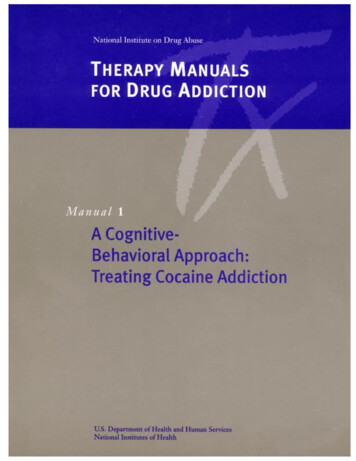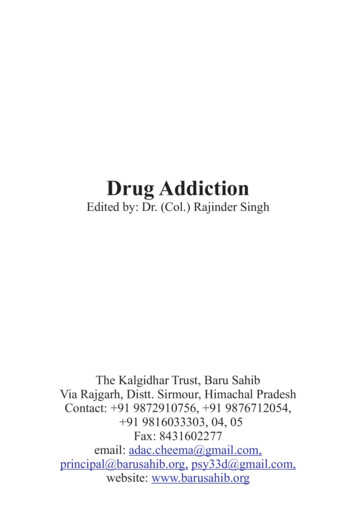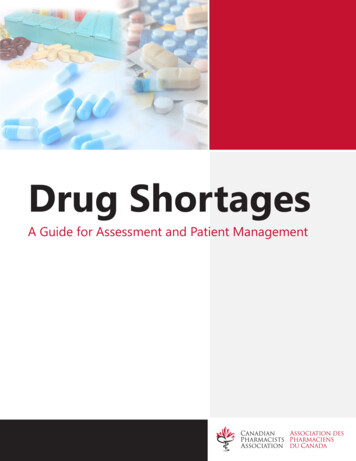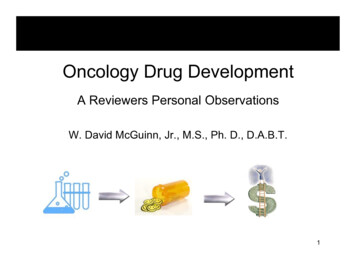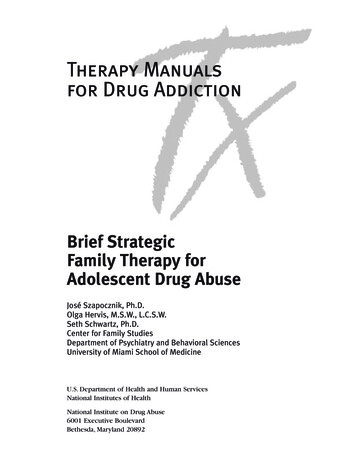
Transcription
Therapy Manualsfor Drug AddictionBrief StrategicFamily Therapy forAdolescent Drug AbuseJosé Szapocznik, Ph.D.Olga Hervis, M.S.W., L.C.S.W.Seth Schwartz, Ph.D.Center for Family StudiesDepartment of Psychiatry and Behavioral SciencesUniversity of Miami School of MedicineU.S. Department of Health and Human ServicesNational Institutes of HealthNational Institute on Drug Abuse6001 Executive BoulevardBethesda, Maryland 20892
ACKNOWLEDGMENTSThis treatment manual was written by Jose Szapocznik, Ph.D., Olga Hervis, M.S.W.,and Seth Schwartz, Ph.D., of the Center for Family Studies, Department of Psychiatryand Behavioral Sciences, at the University of Miami, under contract to the NationalInstitute on Drug Abuse (NIDA). The treatment described in this manual was developedover the course of several decades by a team of researchers and clinicians. Amongthose who were integral to the development of this manual are: Mercedes Scopetta,who founded the University of Miami Center for Family Studies; Daniel Santisteban,who continues to pioneer culturally sensitive family therapy interventions for Hispanicfamilies; Michael Robbins, who directs the Center’s research on in-session processesand their relationship to treatment outcomes; Angel Perez-Vidal, who was the leadtherapist in many BSFT studies; and Victoria Mitrani, who has worked intensively ona BSFT-relevant measure of family functioning.NIDA wishes to thank all who contributed to the development of this manual, includingthe families who participated in this research, without whom this research would nothave been possible.DISCLAIMERThe opinions expressed herein are the views of the authors and do not necessarilyreflect the official policy or position of the National Institute on Drug Abuse or anyother part of the U.S. Department of Health and Human Services. The U.S. Governmentdoes not endorse or favor any specific commercial product.PUBLIC DOMAIN NOTICEAll material appearing in this report is in the public domain and may be reproducedwithout permission from the National Institute on Drug Abuse or the authors. Citationof the source is appreciated.NIH Pub. No. 03-4751Printed August 2003
ForewordMore than 20 years of research has shown that addiction is clearlytreatable. Addiction treatment has been effective in reducing drug useand HIV infection, diminishing the health and social costs that resultfrom addiction, and decreasing criminal behavior. The NationalInstitute on Drug Abuse (NIDA), which supports more than 85 percent of the world’s research on drug abuse and addiction, has foundthat behavioral approaches can be very effective in treating cocaineaddiction.To ensure that treatment providers apply the most current scientifically supported approaches to their patients, NIDA has supportedthe development of the “Therapy Manuals for Drug Addiction” series.This series reflects NIDA’s commitment to rapidly applying basic findings in real life settings. The manuals are derived from those usedefficaciously in NIDA-supported drug abuse treatment studies. Theyare intended for use by drug abuse treatment practitioners, mentalhealth professionals, and all others concerned with the treatment ofdrug addiction.The manuals present clear, helpful information to aid drug treatmentpractitioners in providing the best possible care that science has tooffer. They describe scientifically supported therapies for addiction andprovide guidance on session content and how to implement specifictechniques. Of course, there is no substitute for training and supervision, and these manuals may not be applicable to all types ofpatients nor compatible with all clinical programs or treatmentapproaches. These manuals should be viewed as a supplement to,but not a replacement for, careful assessment of each patient, appropriate case formulation, ongoing monitoring of clinical status, andclinical judgment.The therapies presented in this series exemplify the best of what wecurrently know about treating drug addiction. As our knowledgeevolves, new and improved therapies are certain to emerge. We lookforward to continuously bringing you the latest scientific findingsthrough manuals and other science-based publications. We welcomeyour feedback about the usefulness of this manual series and anyideas you have about how it might be improved.Nora D. Volkow, M.D.DirectorNational Institute on Drug Abuseiii
ContentsPageForeword . . . . . . . . . . . . . . . . . . . . . . . . . . . . . . . . . . . . . . . . . . . . . . iiiChapter 1 Brief Strategic Family Therapy: An Overview . . . . . . . . 1Why Brief Strategic Family Therapy? . . . . . . . . . . . . . . . . . . . . . . . . . . . 2What Are the Goals of Brief Strategic Family Therapy? . . . . . . . . . . . . . 3What Are the Most Common Problems Facing the Family of aDrug-Abusing Adolescent? . . . . . . . . . . . . . . . . . . . . . . . . . . . . . . . . . 3What Is Not the Focus of Brief Strategic Family Therapy? . . . . . . . . . . . 5This Manual . . . . . . . . . . . . . . . . . . . . . . . . . . . . . . . . . . . . . . . . . . . 5Chapter 2 Basic Concepts of Brief Strategic Family Therapy . . . . 7Context . . . . . . . . . . . . . . . . . . . . . . . . . . . . . . . . . . . . . . . . . . . . . . 7Systems . . . . . . . . . . . . . . . . . . . . . . . . . . . . . . . . . . . . . . . . . . . . . . 9Structure: Patterns of Family Interaction . . . . . . . . . . . . . . . . . . . . . . . 10Strategy . . . . . . . . . . . . . . . . . . . . . . . . . . . . . . . . . . . . . . . . . . . . . 11Content Versus Process: A Critical Distinction . . . . . . . . . . . . . . . . . . . 13Chapter 3 Diagnosing Family System Problems . . . . . . . . . . . . . 15Organization . . . . . . . . . . . . . . . . . . . . . . . . . . . . . . . . . . . . . . . . . . . 15Resonance . . . . . . . . . . . . . . . . . . . . . . . . . . . . . . . . . . . . . . . . . . . 17Developmental Stages . . . . . . . . . . . . . . . . . . . . . . . . . . . . . . . . . . . 19Life Context . . . . . . . . . . . . . . . . . . . . . . . . . . . . . . . . . . . . . . . . . . 21Identified Patient . . . . . . . . . . . . . . . . . . . . . . . . . . . . . . . . . . . . . . . . 22Conflict Resolution . . . . . . . . . . . . . . . . . . . . . . . . . . . . . . . . . . . . . 22Chapter 4 Orchestrating Change . . . . . . . . . . . . . . . . . . . . . . . . . 25Establishing a Therapeutic Relationship . . . . . . . . . . . . . . . . . . . . . . . 25Producing Change . . . . . . . . . . . . . . . . . . . . . . . . . . . . . . . . . . . . . . 32v
ContentsPageChapter 5 Engaging the Family Into Treatment . . . . . . . . . . . . . 43The Problem . . . . . . . . . . . . . . . . . . . . . . . . . . . . . . . . . . . . . . . . . 43The Task of Coming to Treatment . . . . . . . . . . . . . . . . . . . . . . . . . . . 46Diagnosing the Interactions That Keep the Family From ComingInto Treatment . . . . . . . . . . . . . . . . . . . . . . . . . . . . . . . . . . . . . . . . 48Complementarity: Understanding How the Family “Pieces”Fit Together to Create Resistance . . . . . . . . . . . . . . . . . . . . . . . . . . . 49Restructuring the Resistance . . . . . . . . . . . . . . . . . . . . . . . . . . . . . . . 49Chapter 6 Clinical Research Supporting Brief StrategicFamily Therapy . . . . . . . . . . . . . . . . . . . . . . . . . . . . . . . . . . . . . . . 55Outpatient Brief Strategic Family Therapy Versus OutpatientGroup Counseling . . . . . . . . . . . . . . . . . . . . . . . . . . . . . . . . . . . . . . 56One Person Brief Strategic Family Therapy . . . . . . . . . . . . . . . . . . . . . 58Brief Strategic Family Therapy Engagement . . . . . . . . . . . . . . . . . . . . 59References . . . . . . . . . . . . . . . . . . . . . . . . . . . . . . . . . . . . . . . . . . . 63Appendices . . . . . . . . . . . . . . . . . . . . . . . . . . . . . . . . . . . . . . . . . . 69APPENDIX A: Training Counselors in Brief Strategic Family Therapy . . 71Selecting Counselors . . . . . . . . . . . . . . . . . . . . . . . . . 71Required Brief Strategic Family Therapy Training:Four Phases . . . . . . . . . . . . . . . . . . . . . . . . . . . . . . . 72Required Supervision . . . . . . . . . . . . . . . . . . . . . . . . 75APPENDIX B: Case Examples . . . . . . . . . . . . . . . . . . . . . . . . . . . . . . 77Case Example I: The Guerrero Family . . . . . . . . . . . . . 77Case Example II: The Hernandez Family . . . . . . . . . . . 82vi
Chapter 1 Brief Strategic Family Therapy:An OverviewBrief Strategic Family Therapy (BSFT) is a brief intervention used totreat adolescent drug use that occurs with other problem behaviors.These co-occurring problem behaviors include conduct problems athome and at school, oppositional behavior, delinquency, associatingwith antisocial peers, aggressive and violent behavior, and risky sexualbehavior (Jessor and Jessor 1977; Newcomb and Bentler 1989;Perrino et al. 2000).BSFT is based on three basic principles. The first is that BSFT is afamily systems approach. Family systems means that family membersare interdependent: What affects one family member affects otherfamily members. According to family systems theory, the drug-usingadolescent is a family member who displays symptoms, includingdrug use and related co-occurring problem behaviors. These symptoms are indicative, at least in part, of what else is going on in thefamily system (Szapocznik and Kurtines 1989). Just as important,research shows that families are the strongest and most enduringforce in the development of children and adolescents (Szapocznikand Coatsworth 1999). For this reason, family-based interventionshave been studied as treatments for drug-abusing adolescents andhave been found to be efficacious in treating both the drug abuse andrelated co-occurring problem behaviors (for reviews, see Liddle andDakof 1995; Robbins et al. 1998; Ozechowski and Liddle 2000).The second BSFT principle is that the patterns of interaction in thefamily influence the behavior of each family member. Patterns ofinteraction are defined as the sequential behaviors among familymembers that become habitual and repeat over time (Minuchin et al.1967). An example of this is an adolescent who attracts attention toherself when her two caregivers (e.g., her mother and grandmother) arefighting as a way to disrupt the fight. In extreme cases, the adolescentmay suffer a drug overdose or get arrested to attract attention to herself when her mother and grandmother are having a very serious fight.The role of the BSFT counselor is to identify the patterns of familyinteraction that are associated with the adolescent’s behavior problems. For example, a mother and grandmother who are arguing1
Chapter 1 Brief Strategic Family Therapy: An Overviewabout establishing rules and consequences for a problem adolescentnever reach an agreement because the adolescent disrupts theirarguments with self-destructive attempts to get attention.Therefore, the third principle of BSFT is to plan interventions thatcarefully target and provide practical ways to change those patternsof interaction (e.g., the way in which mother and grandmotherattempt but fail to establish rules and consequences) that are directlylinked to the adolescent’s drug use and other problem behaviors.Why Brief Strategic Family Therapy?The scientific literature describes various treatment approaches foradolescents with drug addictions, including behavioral therapy,multisystemic therapy, and several family therapy approaches. Eachof these approaches has strengths.BSFT’s strengths include the following:2 BSFT is an intervention that targets self-sustaining changes in thefamily environment of the adolescent. That means that the treatment environment is built into the adolescent’s daily family life. BSFT can be implemented in approximately 8 to 24 sessions.The number of sessions needed depends on the severity of theproblem. BSFT has been extensively evaluated for more than 25 years andhas been found to be efficacious in treating adolescent drugabuse, conduct problems, associations with antisocial peers, andimpaired family functioning. BSFT is “manualized,” and training programs are available tocertify BSFT counselors. BSFT is a flexible approach that can be adapted to a broad rangeof family situations in a variety of service settings (e.g., mentalhealth clinics, drug abuse treatment programs, and other socialservice settings) and in a variety of treatment modalities (e.g., as aprimary outpatient intervention, in combination with residentialor day treatment, and as an aftercare/continuing-care service toresidential treatment). BSFT appeals to cultural groups that emphasize family andinterpersonal relationships.
Chapter 1 Brief Strategic Family Therapy: An OverviewWhat Are the Goals of Brief Strategic Family Therapy?In BSFT, whenever possible, preserving the family is desirable. Whilefamily preservation is important, two goals must be set: to eliminateor reduce the adolescent’s use of drugs and associated problembehaviors, known as “symptom focus,” and to change the familyinteractions that are associated with the adolescent’s drug abuse,known as “system focus.” An example of the latter occurs when families direct their negative feelings toward the drug-abusing youth. Theparents’ negativity toward the adolescent directly affects his or herdrug abuse, and the adolescent’s drug abuse increases the parents’negativity. At the family systems level, the counselor intervenes tochange the way family members act toward each other (i.e., patternsof interaction). This will prompt family members to speak and act inways that promote more positive family interaction, which, in turn,will make it possible for the adolescent to reduce his or her drugabuse and other problematic behaviors.What Are the Most Common ProblemsFacing the Family of a Drug-Abusing Adolescent?The makeup and dynamics of the family are discussed in terms of theadolescent’s symptoms and the family’s problems.The Family Profileof a Drug-AbusingAdolescentResearch shows that many adolescent behavior problems have common causes and that families, in particular, play a large role in thoseproblems in many cases (Szapocznik and Coatsworth 1999). Some ofthe family problems that have been identified as linked to adolescentproblem behaviors include: Parental drug use or other antisocial behavior Parental under- or over-involvement with the adolescent Parental over- or under-control of the adolescent Poor quality of parent-adolescent communication Lack of clear rules and consequences for adolescent behavior Inconsistent application of rules and consequences for adolescentbehaviorInadequate monitoring and management of the adolescent’sactivities with peers Lack of adult supervision of the adolescent’s activities with peers Poor adolescent bonding to family Poor family cohesiveness3
Chapter 1 Brief Strategic Family Therapy: An OverviewSome adolescents may have families who had these problems beforethey began using drugs (Szapocznik and Coatsworth 1999). Otherfamilies may have developed problems in response to the adolescent’s problem behaviors (Santisteban et al. in press).Because family problems are an integral part of the profile of drugabusing adolescents and have been linked to the initiation and maintenance of adolescent drug use, it is necessary to improve conditionsin the youth’s most lasting and influential environment: the family.BSFT targets all of the family problems listed on page 3.The Behavioral Profileof a Drug-AbusingAdolescentNegativity in the Family4Adolescents who need drug abuse treatment usually exhibit a varietyof externalizing behavior problems. These may include: School truancy Delinquency Associating with antisocial peers Conduct problems at home and/or school Violent or aggressive behavior Oppositional behavior Risky sexual behaviorFamilies of drug-abusing adolescents exhibit high degrees of negativity (Robbins et al. 1998). Very often, this negativity takes the formof family members blaming each other for both the adolescent’s andthe family’s problems. Examples might include a parent who refers toher drug-abusing son as “no good” or “a lost cause.” Parents or parentfigures may blame each other for what they perceive as a failure inraising the child. For example, one parent may accuse the other ofhaving been a “bad example,” or for not “being there” when theyoungster needed him or her. The adolescent, in turn, may speakabout the parent accused of setting a bad example with disrespectand resentment. The communication among family members iscontaminated with anger, bitterness, and animosity. To the BSFTcounselor, these signs of emotional or affective distress indicate thatthe work of changing dysfunctional behaviors must start with changingthe negative tone of the family members’ emotions and the negativecontent of their interactions. Research shows that when family negativity is reduced early in treatment, families are more likely to remainin therapy (Robbins et al. 1998).
Chapter 1 Brief Strategic Family Therapy: An OverviewWhat Is Not the Focus of Brief Strategic Family Therapy?BSFT has not been tested with adult addicts. For this reason, BSFT isnot considered a treatment for adult addiction. Instead, when a parentis found to be using drugs, a counselor needs to decide the severity ofthe parent’s drug problem. A parent who is moderately involved withdrugs can be helped as part of his or her adolescent’s BSFT treatment.However, if a parent is drug dependent, the BSFT counselor shouldwork to engage the parent in drug abuse treatment. If the parent isunwilling to get drug abuse treatment, the BSFT counselor shouldwork to protect and disengage the adolescent from the drug dependent parent. This is done by creating an interpersonal wall or boundarythat separates the adolescent and non-drug-using family members fromthe drug dependent parent(s). This process is discussed in Chapter 4in the section on “Working With Boundaries and Alliances,” beginningon page 36.This ManualThis manual introduces counselors to concepts that are needed tounderstand the family as a vital context within which adolescent drugabuse occurs. It also describes strategies for creating a therapeuticrelationship with families, assessing and diagnosing maladaptivepatterns of family interaction, and changing patterns of family interaction from maladaptive to adaptive. This manual assumes that therapistswho adopt these BSFT techniques will be able to engage and retainfamilies in drug abuse treatment and ultimately cause them to behavemore effectively. Chapter 2 will discuss the basic theoretical conceptsof BSFT. Chapter 3 will present the BSFT diagnostic approach, andChapter 4 will explain how change is achieved. Chapter 5 is adetailed discussion of how to engage resistant families of drug-abusingadolescents in treatment. Chapter 6 summarizes some of the researchthat supports the use of BSFT with adolescents. The manual also hastwo appendices, one on training counselors to implement BSFT andanother presenting case examples from the authors’ work. Conceptsand techniques discussed by Minuchin and Fishman (1981) have beenadapted in this BSFT manual for application to drug-abusing adolescents. Additional discussion of BSFT can be found in Szapocznik andKurtines (1989).5
Chapter 2 Basic Conceptsof Brief Strategic Family TherapyThe previous chapter introduced the underlying philosophy of BSFT:to help families help themselves and to preserve the family unit,whenever possible. The remainder of this manual focuses moredirectly on BSFT as a strategy to treat adolescent drug abuse and itsassociated behavior problems. This chapter presents the most basicconcepts of the BSFT approach. It begins with a discussion of fivetheoretical concepts that comprise the basic foundation of BSFT.Some of these concepts may be new for drug abuse counselors. Thefive concepts discussed in this chapter are: Context Systems Structure Strategy Content versus processContextThe social influences an individual encounters have an importantimpact on his or her behavior. Such influences are particularly powerful during the critical years of childhood and adolescence. The BSFTapproach asserts that the counselor will not be able to understand theadolescent’s drug-abusing behavior without understanding what isgoing on in the various contexts in which he or she lives. Drug-abusingbehavior does not happen in a vacuum; it exists within an environment that includes family, peers, neighborhood, and the cultures thatdefine the rules, values, and behaviors of the adolescent.Family as ContextContext, as defined by Urie Bronfenbrenner (1977, 1979, 1986, 1988),includes a number of social contexts. The most immediate are thosethat include the youth, such as family, peers, and neighborhoods.Bronfenbrenner recognized the enormous influence the family has,and he suggested that the family is the primary context in which the7
Chapter 2 Basic Concepts of Brief Strategic Family Therapychild learns and develops. More recent research has supportedBronfenbrenner’s contention that the family is the primary context forsocializing children and adolescents (for reviews, see Perrino et al.2000; Szapocznik and Coatsworth 1999).Peers as ContextConsiderable research has demonstrated the influences that friends’attitudes, norms, and behaviors have on adolescent drug abuse(Brook et al. 1999; Newcomb and Bentler 1989; Scheier andNewcomb 1991). Moreover, drug-using adolescents often introducetheir peers to and supply them with drugs (Bush et al. 1994). In theface of such powerful peer influences, it may seem that parents cando little to help their adolescents.However, recent research suggests that, even in the presence of drugusing (Steinberg et al. 1994) or delinquent (Mason et al. 1994) peers,parents can wield considerable influence over their adolescents. Mostof the critical family issues (e.g., involvement, control, communication,rules and consequences, monitoring and supervision, bonding, familycohesion, and family negativity) have an impact on how much influenceparents can have in countering the negative impact peers have ontheir adolescents’ drug use.Neighborhood as Context The interactions between the family and the context in which thefamily lives may also be important to consider. A family functionswithin a neighborhood context, family members live in a particularneighborhood, and the children in the family are students at aparticular school. For instance, to effectively manage a troubled 15year-old’s behavioral problems in a particular neighborhood, familiesmay have to work against high drug availability, crime, and socialisolation. In contrast, a small town in a semi-rural community mayhave a community network that includes parents, teachers, grandparents, and civic leaders, all of whom collaborate in raising thetown’s children. Neighborhood context, then, can introduce additional challenges to parenting or resources that should be consideredwhen working with families.Culture as Context8Bronfenbrenner also suggested that families, peers, and neighborhoods exist within a wider cultural context that influences the familyand its individual members. Extensive research on culture and thefamily has demonstrated that the family and the child are influencedby their cultural contexts (Santisteban et al. 2003; Szapocznik andKurtines 1993). Much of the researchers’ work has examined theways in which minority families’ values and behaviors have an impacton the relationship between parents and children and affect adolescents’ involvement with drug abuse and its associated problems(Santisteban et al. 2003; Szapocznik and Kurtines 1980, 1993;Szapocznik et al. 1978).
Chapter 2 Basic Concepts of Brief Strategic Family TherapyCounseling as ContextThe counseling situation itself is a context that is associated with a setof rules, expectations, and experiences. The cultures of the client(i.e., the family), the counselor, the agency, and the funding sourcecan all affect the nature of counseling as can the client’s feelingsabout how responsive the “system” is to his or her needs.SystemsSystems are a special case of context. A system is made up of partsthat are interdependent and interrelated. Families are systems that aremade up of individuals (parts) who are responsive (interrelated) toeach other’s behaviors.A Whole Organism“Systems” implies that the family must be viewed as a whole organism.In other words, it is much more than merely the sum of the individuals or groups that it comprises. During the many years that a familyis together, family members develop habitual patterns of behaviorafter having repeated them thousands of times. In this way, each individual member has become accustomed to act, react, and respond ina specific manner within the family. Each member’s actions elicit acertain reaction from another family member over and over againover time. These repetitive sequences give the family its own formand style.The patterns that develop in a family actually shape the behaviorsand styles of each of its members. Each family member has becomeaccustomed to behaving in certain ways in the family. Basically, asone family member develops certain behaviors, such as a responsible,take-control style, this shapes other family members’ behaviors. Forexample, family members may allow the responsible member to handlelogistics. At the same time, the rest of the family members maybecome less responsible. In this fashion, family members complementrather than compete with one another. These behaviors haveoccurred so many times, often without being thought about, that theyhave shaped the members to fit together like pieces of a puzzle—aperfect, predictable fit.Family SystemicInfluencesFamily influences may be experienced as an “invisible force.” Familymembers’ behavior can vary considerably. They may act much differently when they are with other family members than when theyare with people outside the family. By its very presence, the familysystem shapes the behaviors of its members. The invisible forces (i.e.,systemic influences) that govern the behaviors of family members areat work every time the family is together. These “forces” include suchthings as spoken or unspoken expectations, alliances, rules for managing conflicts, and implicitly or explicitly assigned roles.9
Chapter 2 Basic Concepts of Brief Strategic Family TherapyIn the case of an adolescent with behavior problems, the family’s lackof skills to manage a misbehaving youth can create a force (or patternof interaction) that makes the adolescent inappropriately powerful inthe family. For example, when the adolescent dismisses repeatedattempts by the parents to discipline him or her, family memberslearn that the adolescent generally wins arguments, and they changetheir behavior accordingly. Once a situation like this arises in whichfamily expectations, alliances, rules, and so on have been reinforcedrepeatedly, family members may be unable to change these patternswithout outside help.The Principleof ComplementarityThe idea that family members are interdependent, influencing andbeing influenced by each other, is not unique to BSFT. Using differentterminology, the theoretical approach underlying behaviorally orientedfamily treatments might explain these mutual influences as familymembers both serving as stimuli for and eliciting responses from oneanother (Hayes et al. 1999). The theoretical approach underlyingexistential family treatments might describe this influence as familymembers either supporting or constraining the growth of other familymembers (Lantz and Gregoire 2000). What distinguishes BSFT frombehaviorally oriented and existential family treatments is its focus onthe family system rather than on individual functioning.BSFT assumes that a drug-abusing adolescent will improve his or herbehavior when the family learns how to behave adaptively. This willhappen because family members, who are “linked” emotionally, arebehaviorally responsive to each other’s actions and reactions. InBSFT, the Principle of Complementarity holds that for every action bya family member there is a corresponding reaction from the rest ofthe family. For instance, often children may have learned to coerceparents into reinforcing their negative behavior—for example, bythrowing a temper tantrum and stopping only when the parents givein (Patterson 1982; Patterson and Dishion 1985; Patterson et al. 1992).Only when the parents change their behavior and stop reinforcing or“complementing” negative behavior will the child change.Structure: Patterns of Family InteractionAn exchange among family members, either through actions orconversations, is called an interaction. In time, interactions becomehabitual and repetitive, and thus are referred to as patterns of interaction (Minuchin 1974). Patterns of family interaction are the habitualand repeated behaviors family members engage in with each other.More specifically, the patterns of family interaction are comprisedof linked chains of behavior that occur among family members. Asimple example can be illustrated by observing that family memberschoose to sit at the same place at the dinner table every day. Wherepeople sit may make it easier for them to speak with each other and10
Chapter 2 Basic Concepts of Brief Strategic Family Therapynot with others. Consequently, a repetitive pattern of interactionreflected in a “sitting” pattern is likely to predict the “talking” pattern.A large number of these patterns of interaction will develop in anysystem. In families, this constellation of repetitive patterns of interactionis called the family “structure.”The repetitive patterns of interaction that make up a family’s structurefunction like a script for a play that the actors have read, memorized,and re-enact constantly. When one actor says a certain line from thescript or performs a certain action, that is the cue
Therapy Manuals for Drug Addiction Brief Strategic Family Therapy for Adolescent Drug Abuse José Szapocznik, Ph.D. Olga Hervis, M.S.W., L.C.S.W. . This series reflects NIDA's commitment to rapidly applying basic find-ings in real life settings. The manuals are derived from those used efficaciously in NIDA-supported drug abuse treatment .
